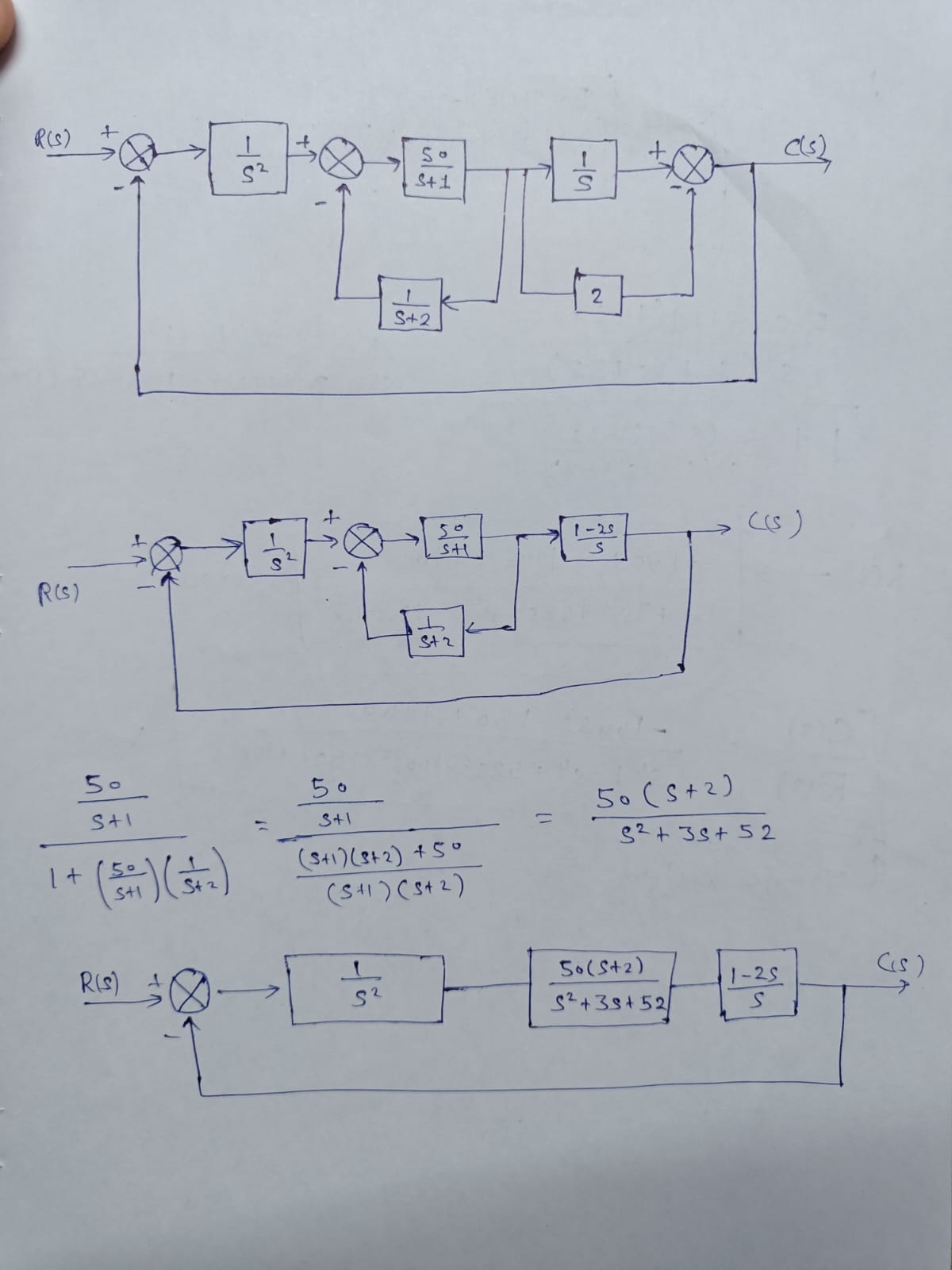C(s) Reduce the block diagram to a single transfer function, G(s) = R(S) 16 R(S) + 50 s+1 s+2 S ¹0 2 C(s)
C(s) Reduce the block diagram to a single transfer function, G(s) = R(S) 16 R(S) + 50 s+1 s+2 S ¹0 2 C(s)
Introductory Circuit Analysis (13th Edition)
13th Edition
ISBN:9780133923605
Author:Robert L. Boylestad
Publisher:Robert L. Boylestad
Chapter1: Introduction
Section: Chapter Questions
Problem 1P: Visit your local library (at school or home) and describe the extent to which it provides literature...
Related questions
Question

Transcribed Image Text:**Title: Reducing a Block Diagram to a Single Transfer Function**
**Objective:**
To convert the given block diagram into a single transfer function, represented as \( G(s) = \frac{C(s)}{R(s)} \).
**Block Diagram Description:**
1. **Input Signal:**
- The system begins with the input \( R(s) \).
2. **Summing Junction 1:**
- Subtracts feedback from the loop, proceeding to the block with \( \frac{1}{s} \).
3. **Block 1:**
- Transfer function of \( \frac{1}{s} \).
4. **Summing Junction 2:**
- Combines the output from Block 1 with feedback from later in the system before entering the next block.
5. **Block 2:**
- Transfer function of \( \frac{50}{s+1} \).
6. **Branching Points:**
- Outputs from Block 2 branch into two pathways.
- Pathway 1 enters the block with transfer function \( \frac{1}{5} \).
- Pathway 2 enters a series of two blocks with transfer functions \( \frac{1}{s+2} \) and \( 2 \).
7. **Output Summing Junction:**
- The outputs of both pathways combine, with feedback, leading to the next stage.
8. **Feedback Loop:**
- Connects back to both Summing Junction 1 and the summing point between Pathway 1 and the feedback path.
**Objective Conclusion:**
The aim is to simplify this configuration to a single transfer function \( G(s) = \frac{C(s)}{R(s)} \), encompassing all the dynamic responses of the system into one relation.
Expert Solution
Step 1: Simplifying the block diagram

Trending now
This is a popular solution!
Step by step
Solved in 3 steps with 3 images

Knowledge Booster
Learn more about
Need a deep-dive on the concept behind this application? Look no further. Learn more about this topic, electrical-engineering and related others by exploring similar questions and additional content below.Recommended textbooks for you

Introductory Circuit Analysis (13th Edition)
Electrical Engineering
ISBN:
9780133923605
Author:
Robert L. Boylestad
Publisher:
PEARSON

Delmar's Standard Textbook Of Electricity
Electrical Engineering
ISBN:
9781337900348
Author:
Stephen L. Herman
Publisher:
Cengage Learning

Programmable Logic Controllers
Electrical Engineering
ISBN:
9780073373843
Author:
Frank D. Petruzella
Publisher:
McGraw-Hill Education

Introductory Circuit Analysis (13th Edition)
Electrical Engineering
ISBN:
9780133923605
Author:
Robert L. Boylestad
Publisher:
PEARSON

Delmar's Standard Textbook Of Electricity
Electrical Engineering
ISBN:
9781337900348
Author:
Stephen L. Herman
Publisher:
Cengage Learning

Programmable Logic Controllers
Electrical Engineering
ISBN:
9780073373843
Author:
Frank D. Petruzella
Publisher:
McGraw-Hill Education

Fundamentals of Electric Circuits
Electrical Engineering
ISBN:
9780078028229
Author:
Charles K Alexander, Matthew Sadiku
Publisher:
McGraw-Hill Education

Electric Circuits. (11th Edition)
Electrical Engineering
ISBN:
9780134746968
Author:
James W. Nilsson, Susan Riedel
Publisher:
PEARSON

Engineering Electromagnetics
Electrical Engineering
ISBN:
9780078028151
Author:
Hayt, William H. (william Hart), Jr, BUCK, John A.
Publisher:
Mcgraw-hill Education,